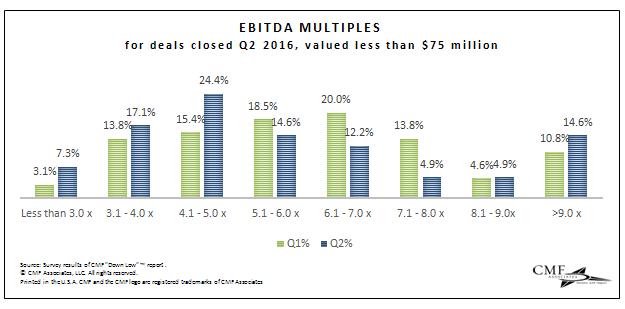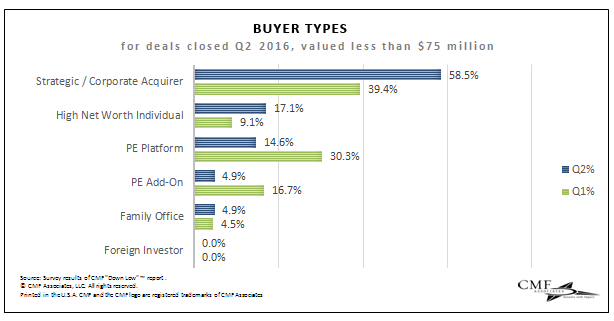
Editor’s Note: Every quarter, Philadelphia-based CMF Associates produces its “Down Low” report aimed at providing relevant data on lower middle-market M&A activity as a real time barometer for professionals working at this end of the market. We asked CMF’s Founder and Managing Director Thomas Bonney to interpret the most recent report and provide ABL Advisor readers with his thoughts as to how the report’s findings might impact asset-based lenders financing borrowers in the lower middle market.
CMF conducted its Q2 survey of investment bankers and brokers who specialize in selling businesses in the lower end of the middle market, specifically for transactions valued at less than $75 million and summarized these in our Down Low™ report.
Current State of Lower Middle Market M&A
The report showed a general skewing of deals towards the smaller size, with deals with revenues of $5 million to $10 million comprising 45.0% of the total transactions, up from 37.5% in Q1, and deals with revenues in the $11 million to $20 million range comprising 25.0% of deals, compared with 16.4% in Q1.

In conjunction with the decline in revenue at the acquired entities, we saw decreases in the acquisition multiples from all categories greater than 5.1 times EBITDA and report increases in all categories less than 5.0 times.

A surprising result this quarter was that strategic buyers represented 58.5% of the total number of transactions, up from 39.4% in Q1. However, in PitchBook’s report on second quarter M&A activity, add-on acquisitions represented 64.0% of the total number of deals closed in the second quarter, up from 61.0% in 2015. Over the past ten years, add-on investments have been comprising a regularly increasing percentage of the total number of transactions, up from 43.0% in 2006 to the aforementioned 64.0% this year.

Our survey also showed that 53.5% of the sell-side bankers reported no debt at close. This does not mean that the deals were 100% financed by cash on hand, but that the acquirer did not need any deal-specific debt financing to complete the transaction. Said one respondent, “Our strategic acquirer had a line of credit at the corporate level that, when combined with the cash on hand, provided for adequate capital to fund the bolt-on acquisition.”

During the months of July and August, the deal origination team has seen an uptick in quality deal volume compared with Q2. Furthermore, we are hearing anecdotal commentary from our network of over 450 sell side bankers that this is another wave of deals getting teed up for release to the market after Labor Day. As such, we believe that the lower level of the middle market will see increasing volume and quality post-Labor Day through year end.
Current State of Transaction-Based ABL Lending in Lower Middle Market
Banks are also reporting that the sponsor market continues to be soft relative to prior years with strategic acquirers closing a larger portion of deals. Many of the opportunities that ABL originators surface make good referrals to other sections of their bank.
For “A” assets with sound business models, recurring revenue and competitive market positions there are a large number of lenders in the mix. This is resulting in low pricing for these companies and heavy competitive negotiation on other terms and conditions; lower middle-market ABL rates are estimated at LIBOR plus 225-300 bps (+ or -).
Conversely, for lesser quality deals, we are seeing evidence of underwriters becoming more concerned about lending into these less-than-perfect companies, particularly given the length of this current economic cycle. An example of some level of anxiety is noted in this quote reported by a banker on a deal that closed in Q2: “There were a lot of seller add backs, so bank financing was challenging. We worked with a small regional bank on the SBA package.” The implication here being that underwriters prefer to lend against GAAP basis EBITDA as opposed to adjusted EBITDA and are looking to the SBA for some additional security.
Sponsors report that community bank-based ABL groups continue to be difficult sources of capital for transaction-based acquisitions because these lending institutions generally do not have a full grasp of the underwriting issues at the lower end of the middle market and do not have an appreciation for the subordinated debt that is generally required in sponsor-backed transaction financing.
In the lower end of the middle market, our PE fund clients see unitranche loans priced from 8.0% to 11.0% and mezzanine debt from 12.0% to 14.0% cash interest (plus PIK and warrant or small equity participation for the mezzanine debt). Even with senior debt generally trading in and around 4%, and asset-based loans lower, PE funds at the lower end often prefer higher priced notes, due to the ability to secure longer amortization periods and higher turns of debt over the senior lenders (particularly for these smaller deals) and the significantly less intrusive covenant terms that come with asset-based lending.
Continued on Page 2...